

Dr. Charles Henry Corneal Hysteresis in Post-Radial Keratotomy Primary Open Angle Glaucoma Joshua Hardin, MD UAMS Jones Eye Institute Table Rock Regional Roundup September 23, 2016 Disclosures • No disclosures 1
Corneal Hysteresis and the Ocular Response Analyzer (ORA) The Ocular Response Analyzer (ORA, Reichert Technologies, Depew, NY) is a dynamic pneumotonometer which measures corneal hysteresis (CH) – a biomechanical property described as corneal viscosity. https://youtu.be/0Bo1iWg WQes ORA Printout • IOPcc – cornea- correlated pressure • IOPg – goldmann- correlated pressure • CH – corneal hysteresis • CRF – corneal resistance factor Factors of Influence • Axial length • Refractive error • Corneal Thickness • Diabetes • Age • Race • Refractive Surgery Mangouritsas, G., Morphis, G., Mourtzoukos, S., & Feretis, E. (2009). Association Between Corneal Hysteresis and Central Corneal Thickness in Glaucomatous and Non-Glaucomatous Eyes. Acta Ophthalmologica, 87: 901-905. Wong, Y., & Lam, A. (2015). The Roles of Cornea and Axial Length in Corneal Hysteresis Among Emmetropies and High Myopes: A Pilot Study. Current Eye Research, 40 (3): 282-289. Castro, D., Prata, T., Lima, V., Biteli, L., Vasconcelos de Moraes, C., & Paranhos, A. (2010). Corneal Viscoelasticity Differences Between Diabetic and Non- Diabetic Glaucoma Patients. Journal of Glaucoma, 19: 341-343. Kirwan, C., & O'Keefe, M. (2008). Corneal Hysteresis Using the Reichert Ocular Response Analyser: Findings Pre- and Post-LASIK and LASEK. ACTA Ophthalmologica, 86: 215-218. Ortiz, D., Pinero, D., Shabayek, M., Arnalich-Montiel, F., & Alio, J. (2007). Corneal Biomechanical Properties in normal, post-LASIK, and Keratoconic Eyes. Journal of Cataract and Refractive Surgery, 1371-1375. 2
Background Low corneal hysteresis has been shown to be associated with optic nerve and visual field damage and risk for progression in primary open angle glaucoma (POAG). No studies have thus far examined the effect of radial keratotomy on corneal hysteresis in POAG. Deol, M., Taylor, D., & Radcliffe, N. (2015). Corneal Hysteresis and Its Relevance to Glaucoma. Current Opinions in Ophthalmology, 1-7. Purpose To determine whether there is a difference in corneal hysteresis between POAG patients with RK and myopic, non-RK POAG patients and whether this difference could affect pressure measurement between the groups. Methods • Two groups of glaucoma patients of the Little Rock Eye Clinic, Little Rock, AR were prospectively recruited. – POAG with prior RK – POAG with myopia (> -3.00) 3
Methods • Historical survey, slit lamp examination of incisions / optical size, Goldmann Applanation IOP, Corneal Topography for central 4 mm zone K, IOL Master for Axial Length, and ORA testing (4 successive trials per eye) were performed Demographics Results 4
Results When AL and CCT were factored in, RK status on CH was significant ( p < 0.001 ) with an estimated difference of 1.16 mmHg. Diabetes was added and the effect of RK status remained significant ( p < 0.001 ) with an estimated difference of 1.01 mmHg. Significant differences were detected in the gcIOP ( 1.89 mmHg , p = 0.00854 ) and ccIOP ( 2.62 mmHg , p=0.000308 ) between the two groups when GA, CCT, AL were factored in. Limitations • Limitations of our study include: lack of other control groups, non-matched participants (secondary to difficulty in obtaining pre-RK records) Conclusions CH is lower by ~ 1.01 mmHg in patients with RK and POAG compared to myopic POAG patients. gcIOP is higher by ~ 1.89 mmHg and ccIOP is higher by ~ 2.62 mmHg in patients with RK and POAG compared to myopic POAG patients. This study suggests that ORA data of patients with RK should be interpreted differently and this may affect the diagnosis and management of POAG. 5
Clinical Application Radial Keratotomy Myopia and and Glaucoma Glaucoma Goldmann 16.12 mmHg 16.49 mmHg Applanation Corneal 8.97 mmHg 10.13 mmHg Hysteresis Goldmann- 17.06 mmHg 15.17 mmHg Correlated IOP Cornea- 18.61 mmHg 15.99 mmHg Correlated IOP Wrap-Up • CH plays a major role in glaucoma – similar to that of central corneal thickness. • In RK patients corneal hysteresis is reduced and ccIOP is significantly higher. Support / Contributors Coauthors: Lydia Lane, Grant Morshedi, Christian Hester, J. Charles Henry Little Rock Eye Clinic: Shauna Pritchett, Stevi Riddle, Megan Vandament University of Arkansas Medical Sciences, Translational Research Institute: C. Michael Bailey, Horace J. Spencer, III Jones Eye Institute 6
Questions? 7
Recommend
More recommend